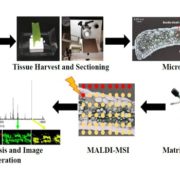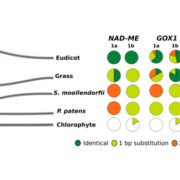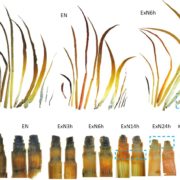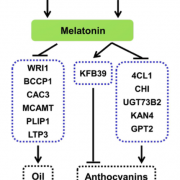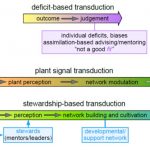The vitamin B1 family grows: detection and roles of thiamine triphosphate in plants (Plant Direct)
 The term “vitamin B1” indicates a family of molecules that includes thiamine, thiamine monophosphate and thiamine diphosphate (TDP). The latter is the most famous family member and plays a pivotal role in carbon metabolism. Thanks to an optimized detection protocol, Hofmann and colleagues have demonstrated that Arabidopsis thaliana shoots also produce thiamine triphosphate (TTP). The production of TTP is likely due to the proton motive force in mitochondria and/or plastids and TDP is its most likely precursor. The accumulation of TTP increases with light intensity and peaks during the day, but is independent of the circadian clock. It rather reflects the biosynthesis of TDP, which is a photosynthesis-driven process that takes place in green tissues. Because of the concomitant accumulation of TDP and TTP, the authors hypothesize that conversion of TDP to TTP may serve to dissipate excess free TDP, especially in the plastids and/or mitochondria. In analogy with what has been recently observed in mammals, plant TTP could also modulate important enzymes involved in amino acid biosynthesis. (Summary by Elisa Dell’Aglio) Plant Direct 10.1002/pld3.258
The term “vitamin B1” indicates a family of molecules that includes thiamine, thiamine monophosphate and thiamine diphosphate (TDP). The latter is the most famous family member and plays a pivotal role in carbon metabolism. Thanks to an optimized detection protocol, Hofmann and colleagues have demonstrated that Arabidopsis thaliana shoots also produce thiamine triphosphate (TTP). The production of TTP is likely due to the proton motive force in mitochondria and/or plastids and TDP is its most likely precursor. The accumulation of TTP increases with light intensity and peaks during the day, but is independent of the circadian clock. It rather reflects the biosynthesis of TDP, which is a photosynthesis-driven process that takes place in green tissues. Because of the concomitant accumulation of TDP and TTP, the authors hypothesize that conversion of TDP to TTP may serve to dissipate excess free TDP, especially in the plastids and/or mitochondria. In analogy with what has been recently observed in mammals, plant TTP could also modulate important enzymes involved in amino acid biosynthesis. (Summary by Elisa Dell’Aglio) Plant Direct 10.1002/pld3.258


